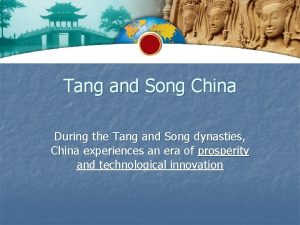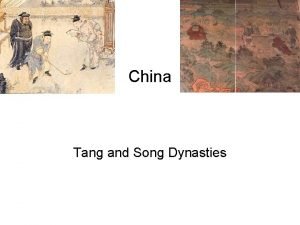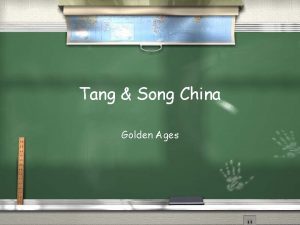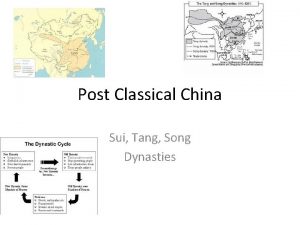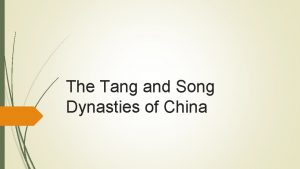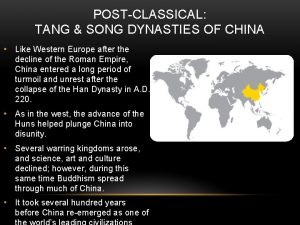China During the Tang Song Dynasties China under









- Slides: 9

China During the Tang & Song Dynasties China under Tang dynasty, 700 China under Song dynasty, 1142

I. Beyond Ancient China 220 – Han dynasty collapses For 350 years afterwards, more than 30 dynasties attempt rule 589 – Emperor Wendi reunites China, beginning the short-lived Sui dynasty Restores strong central government, united most of China Murdered by own son, Yangdi Focused on Confucian education system, brought back examination system for incoming bureaucrats Ordered the Grand Canal to be built Connected two major rivers: Huange He and Chang Jiang Trade flourished between the northern and southern regions Led a life of extravagance, assassinated in 618

II. Tang Dynasty (618 -907) Tang Taizong founded Tang dynasty, which ruled China for almost 300 years Built on the foundations of the Sui dynasty Reconquered northern and western lands, expanded deep into central Asia Expansion of bureaucracy Expanded civil service exam Open to all men, but only wealthy could afford the necessary education Education/position in gov’t became more important than nobility Scholar-Officials became more dominant and powerful than old aristocratic families

II. Continued… • Empress Wu • • First and only woman to assume the title of Emperor in China Began by ruling behind the scenes of her husband sons Used harsh tactics, secret police to quell opposition Promoted Buddhism throughout empire • After Wu, severe backlash against Buddhism by Confucian and Daoist scholars • Decline of Tang dynasty – – – Had trouble controlling vast empire Nomadic invasions, high taxes, internal rebellions Last emperor, a child, was murdered in 907

III. Song Dynasty (960 -1279) China once again divided after Tang dynasty Emperor Taizu reunited China, proclaimed himself first Song emperor Smaller empire than Tang, no control over western lands, lost northern lands Nomadic peoples of north a constant problem Eventually pushed south of Huang He (Yellow River) Focus on Confucianism Neo-Confucians – argued that virtue was obtained through learning Despised foreign philosophical systems, such as Buddhism Social harmony arose from keeping place and rank

III. Continued… Reform attempts Northern nomadic invaders and lack of military focus began to take its toll Wang Anshi, an emperor’s advisor, brought sweeping reforms in an attempt to keep dynasty from collapsing Issued cheap loans and irrigations projects to encourage agricultural expansion Taxed landowners and gentry class Used money to build better-trained armies

III. Continued… Decline Late 11 th century, neo-Confucians gained power, reversed reforms Economy began to deteriorate, social unrest increased Pushed south by northern kingdoms, became known as Southern Song dynasty Lasted 150 years, fell to the Mongols

IV. Advances in Technology & Knowledge • During Tang & Song dynasties, many innovations and advancements occurred • • • Movable type – movable, carved blocks could be arranged for printing Gun powder – originally for fireworks, led to bombs, canons, etc. Agricultural advancements led to rapid growth – Improved the cultivation of rice • International trade was important – Silk Roads, later ocean routes – Helped economy and spread of culture

V. Social Changes • China becomes more urban – Ten cities with over 1 million people • Class system changes – Gentry– larger upper-class emerges • • – – Passing civil service exam ensured special social status • Could wear certain clothing, exempt from corporal punishment Family name still greatly influenced positions and success Middle class – merchants, skilled artisans, minor officials Peasant farmers still represented largest class • Status of women declined – – Neo-Confucians pushed for male dominance of family and society Feet binding – sign of wealth, prestige
